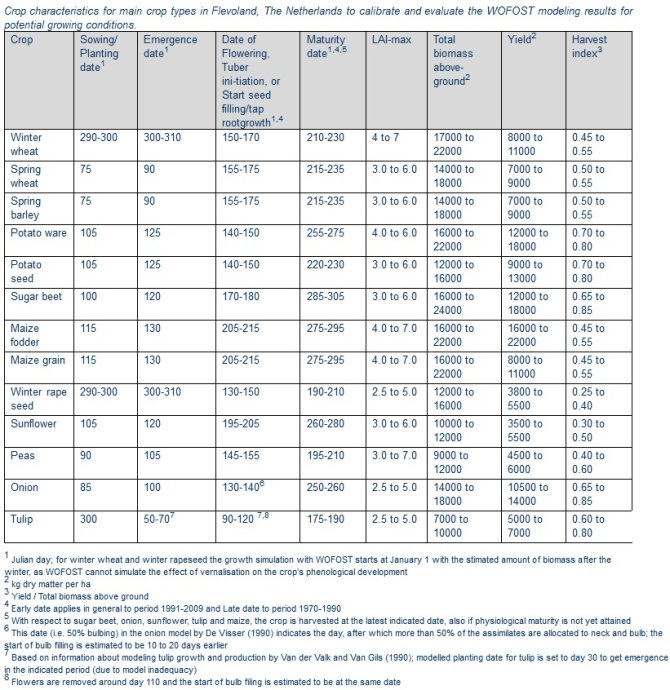
Uitgave
Crop Modelling: Input Data
Characteristics for the main crop types in Flevoland have been compiled (see table below), such as the sowing and maturity dates and yield levels under optimal growing conditions. These data have been used for calibrating the WOFOST model for the different crop types growing under current conditions.
Meteorological parameters
The meteorological parameters used by WOFOST are:
- maximum temperature
- minimum temperature
- global radiation
- windspeed
- vapor pressure
- evapotranspiration
- rainfall
The meteorological data are often measured on a daily basis, and are obtained from the KNMI ’06 scenarios.
Crop parameters for Flevoland
Characteristics for the main crop types in Flevoland have been compiled (see table below), such as the sowing and maturity dates and yield levels under optimal growing conditions. These data have been used for calibrating the WOFOST model for the different crop types growing under current conditions.
The simulation runs with WOFOST have been done first for the main crops (13 in total) in Flevoland and the current weather conditions (period 1992-2008). These runs have been done for the current crop varieties and current sowing dates and next, the runs have been repeated for the four KNMI climate scenarios for a period around 2050. In all simulation runs the soil is at field capacity at the start of the year, has an available moisture fraction of 20% (being representative for the loamy and clay soils in Flevoland), is well-drained (hence, water excess practically does not affect crop growth), and is deep (hence, soil water availability is only limited by the maximal rooting depth as dependent on the crop type).

Adaptation options
The effectiveness of adaptation to climatic change has been established by repeating the simulations for the four KNMI scenarios and changing the sowing date (i.e. 15 days earlier except for winter wheat and winter rapeseed) and the varieties (assuming more southern varieties with temperature requirements for phenological development that are 10% higher than those of the current varieties, and with a 10% longer lifespan of leaves).
Source
Wolf, J., M. Mandryk, A. Kanellopoulos, P. van Oort, B. Schaap, P. Reidsma and M. van Ittersum, 2010. Methodologies for analyzing future farming systems in Flevoland as applied within the AgriAdapt project. AgriAdapt project report no. 1, Wageningen UR.